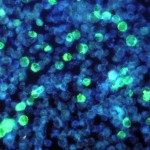Link to Pubmed [PMID] – 15585844
J. Immunol. 2004 Dec;173(12):7223-9
MHC class I-specific inhibitory receptors are expressed by a subset of memory-phenotype CD8(+) T cells. Similar to NK cells, MHC class I-specific inhibitory receptors might subserve on T cells an important negative control that participates to the prevention of autologous damage. We analyzed here human CD8(+) T cells that express the Ig-like MHC class I-specific inhibitory receptors: killer cell Ig-like receptor (KIR) and CD85j. The cell surface expression of Ig-like inhibitory MHC class I receptors was found to correlate with an advanced stage of CD8(+) T cell maturation as evidenced by the reduced proliferative potential of KIR(+) and CD85j(+) T cells associated with their high intracytoplasmic perforin content. This concomitant regulation might represent a safety mechanism to control potentially harmful cytolytic CD8(+) T cells, by raising their activation threshold. Yet, KIR(+) and CD85j(+) T cells present distinct features. KIR(+)CD8(+) T cells are poor IFN-gamma producers upon TCR engagement. In addition, KIR are barely detectable at the surface of virus-specific T cells during the course of CMV or HIV-1 infection. By contrast, CD85j(+)CD8(+) T cells produce IFN-gamma upon TCR triggering, and represent a large fraction of virus-specific T cells. Thus, the cell surface expression of Ig-like inhibitory MHC class I receptors is associated with T cell engagement into various stages of the cytolytic differentiation pathway, and the cell surface expression of CD85j or KIR witnesses to the history of qualitatively and/or quantitatively distinct T cell activation events.

